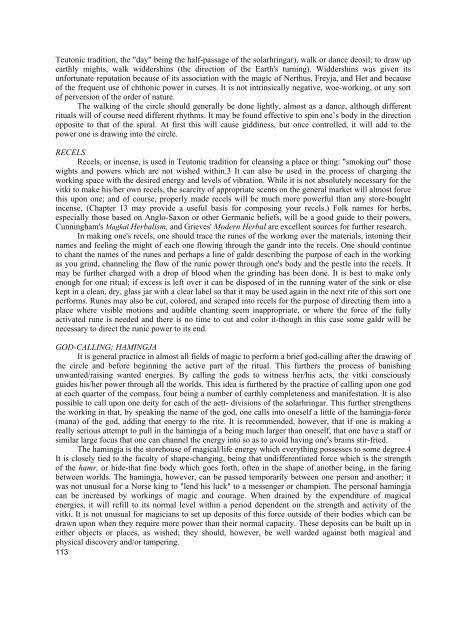TEUTONIC MAGIC - Awaken Video
TEUTONIC MAGIC - Awaken Video
TEUTONIC MAGIC - Awaken Video
Create successful ePaper yourself
Turn your PDF publications into a flip-book with our unique Google optimized e-Paper software.
Teutonic tradition, the "day" being the half-passage of the solarhringar), walk or dance deosil; to draw up<br />
earthly mights, walk widdershins (the direction of the Earth's turning). Widdershins was given its<br />
unfortunate reputation because of its association with the magic of Nerthus, Freyja, and Het and because<br />
of the frequent use of chthonic power in curses. It is not intrinsically negative, woe-working, or any sort<br />
of perversion of the order of nature.<br />
The walking of the circle should generally be done lightly, almost as a dance, although different<br />
rituals will of course need different rhythms. It may be found effective to spin one’s body in the direction<br />
opposite to that of the spiral. At first this will cause giddiness, but once controlled, it will add to the<br />
power one is drawing into the circle.<br />
RECELS<br />
Recels, or incense, is used in Teutonic tradition for cleansing a place or thing: "smoking out" those<br />
wights and powers which are not wished within.3 It can also be used in the process of charging the<br />
working space with the desired energy and levels of vibration. While it is not absolutely necessary for the<br />
vitki to make his/her own recels, the scarcity of appropriate scents on the general market will almost force<br />
this upon one; and of course, properly made recels will be much more powerful than any store-bought<br />
incense, (Chapter 13 may provide a useful basis for composing your recels.) Folk names for herbs,<br />
especially those based on Anglo-Saxon or other Germanic beliefs, will be a good guide to their powers,<br />
Cunningham's Magkal Herbalism, and Grieves' Modern Herbal are excellent sources for further research.<br />
In making one's recels, one should trace the runes of the workmg over the materials, intoning their<br />
names and feeling the might of each one flowing through the gandr into the recels. One should continue<br />
to chant the names of the runes and perhaps a line of galdr describing the purpose of each in the working<br />
as you grind, channeling the flow of the runic power through one's body and the pestle into the recels. It<br />
may be further charged with a drop of blood when the grinding has been done. It is best to make only<br />
enough for one ritual; if excess is left over it can be disposed of in the running water of the sink or else<br />
kept in a clean, dry, glass jar with a clear label so that it may be used again in the next rite of this sort one<br />
performs. Runes may also be cut, colored, and scraped into recels for the purpose of directing them into a<br />
place where visible motions and audible chanting seem inappropriate, or where the force of the fully<br />
activated rune is needed and there is no time to cut and color it-though in this case some galdr will be<br />
necessary to direct the runic power to its end.<br />
GOD-CALLING; HAMINGJA<br />
It is general practice in almost all fields of magic to perform a brief god-calling after the drawing of<br />
the circle and before beginning the active part of the ritual. This furthers the process of banishing<br />
unwanted/raising wanted energies. By calling the gods to witness her/his acts, the vitki consciously<br />
guides his/her power through all the worlds. This idea is furthered by the practice of calling upon one god<br />
at each quarter of the compass, four being a number of earthly completeness and manifestation. It is also<br />
possible to call upon one deity for each of the aett- divisions of the solarhringar. This further strengthens<br />
the working in that, by speaking the name of the god, one calls into oneself a little of the hamingja-force<br />
(mana) of the god, adding that energy to the rite. It is recommended, however, that if one is making a<br />
really serious attempt to pull in the hamingja of a being much larger than oneself, that one have a staff or<br />
similar large focus that one can channel the energy into so as to avoid having one's brains stir-fried.<br />
The hamingja is the storehouse of magical/life energy which everything possesses to some degree.4<br />
It is closely tied to the faculty of shape-changing, being that undifferentiated force which is the strength<br />
of the hamr, or hide-that fine body which goes forth, often in the shape of another being, in the faring<br />
between worlds. The hamingja, however, can be passed temporarily between one person and another; it<br />
was not unusual for a Norse king to "lend his luck" to a messenger or champion. The personal hamingja<br />
can be increased by workings of magic and courage. When drained by the expenditure of magical<br />
energies, it will refill to its normal level within a period dependent on the strength and activity of the<br />
vitki. It is not unusual for magicians to set up deposits of this force outside of their bodies which can be<br />
drawn upon when they require more power than their normal capacity. These deposits can be built up in<br />
either objects or places, as wished; they should, however, be well warded against both magical and<br />
physical discovery and/or tampering.<br />
113
















